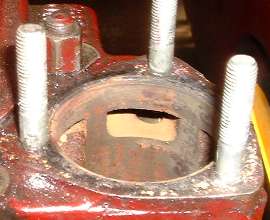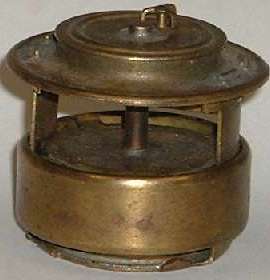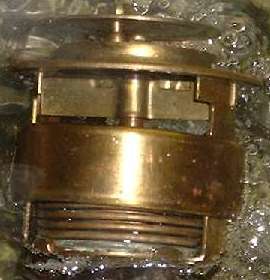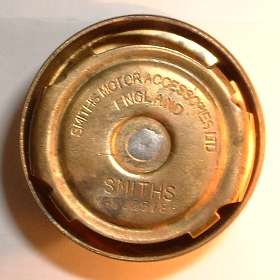The MGA With An Attitude
THERMOSTAT, ORIGINAL TYPE with Moving Sleeve - CO-103A
 First check out the picture on the right (click for larger image). This is the coolant discharge port on the cylinder head where the thermostat will be installed. Notice the large slot in the side wall with the small round hole in the floor. This is the bypass port which allows passage of some coolant directly from the cylinder head downward into the water pump, bypassing the radiator. This allows internal circulation to heat coolant in the water jacket during warm up while avoiding hot spots in the cylinder head. The port opening is 3/8" down the wall, and 3/8" tall (bottom of bypass port 3/4" down the wall). The vertical wall all the rest of the way around the thermostat opening is 5/16" tall and 1-15/16" diameter. The original type sliding sleeve thermostat (below) has a sleeve 5/8" tall with diameter of about 1-29/32", which puts the sleeve very close to the wall. This will nicely cover the bypass port when the thermostat opens.
First check out the picture on the right (click for larger image). This is the coolant discharge port on the cylinder head where the thermostat will be installed. Notice the large slot in the side wall with the small round hole in the floor. This is the bypass port which allows passage of some coolant directly from the cylinder head downward into the water pump, bypassing the radiator. This allows internal circulation to heat coolant in the water jacket during warm up while avoiding hot spots in the cylinder head. The port opening is 3/8" down the wall, and 3/8" tall (bottom of bypass port 3/4" down the wall). The vertical wall all the rest of the way around the thermostat opening is 5/16" tall and 1-15/16" diameter. The original type sliding sleeve thermostat (below) has a sleeve 5/8" tall with diameter of about 1-29/32", which puts the sleeve very close to the wall. This will nicely cover the bypass port when the thermostat opens.
Now take a look at the original type thermostat first, pictured below. This thermostat has a large brass bellows in the bottom containing a volatile fluid. It also has a wide moving ring around the outside near the bottom. In the cylinder head the bypass port is located just above this moving ring. When the coolant is below normal operating temperature and the thermostat is closed a small amount of the coolant can enter the bypass hole in the cylinder head where it is ducted to the water pump to be recirculated through the engine. This allows for coolant circulation in the engine while it is warming up without allowing coolant to circulate through the radiator. End result is that the engine warms up to normal operating temperature quickly. When the volatile fluid in the therostat is heated it boils and expands, spreading the bellows to open the thermostat. It is the content and mixture of this fluid that determines at what temperature the thermostat will open. When the lid on top is lifted the band around the side is also raised, which in turn blocks the bypass hole in the cylinder head. This then forces all of the coolant circulation to go through the radiator after the engine is up to full operating temperature.
 
When the outer ring is raised to within 3/8" of the top flange it will completely block the bypass port. When the ring is raised within 5/16" of the top flange it blocks passage of coolant above the ring, and all coolant flow must pass inside of the ring, betweeen the ring and the bellows. The flow area inside the ring all the way around the bellows is aproximately 0.8 sq.in. cross section. The open area of the top valve in full open position is about 1.2 sq.in., so it is not particularly restrictive to flow. This one will open a little farther, but it was hard to take the picture fast enough after it was partially lifted from the hot water. Apparently the 0.8 sq.in. flow apperature is not too restrictive to flow, as these thermostats have worked well for decades. For racing applications it is common to replace the thermostat with the blanking sleeve to remove this flow restriction completely.

Just for a side note, I have two of these old thermostats that were removed from 40 year old cars in a junk yard, and they still work like new. Similar to brass floats in a carburetor, as long as they don't spring a leak they should continue to work indefinitely. There is no moving seal. The bellows unit is soldered shut at assembly after installation of the working fluid, small hole in center at bottom (click for larger image). The part number under the word "SMITHS" is X85025/86. The "86" is the operating temperature in degrees centigrade (86°C = 187°F.)
ADDENDUM 10/20/04:
Pat Jenkins is a thermostat engineer for Robertshaw.
At 12:08 AM 10/20/04 +0000, Pat Jenkins <jenko@comcast.net> wrote:
"Wiith the introduction of pressurized cooling system, manufacturers discovered that the system pressure would cause the bellows thermostats to operate eratically".
Well that makes sense. The bellows is a bit more than 1 inch diameter, so about 1 sq-in area on one end. Working pressure in the cooling system would apply force on the ends of the bellows tending to close the thermostat (about 1 pound of force for each 1 psi of pressure). To test this I put the bellows thermostat in a pan of boiling water to bring it to the full open position. I then applied force to the valve plate with a spring scale. Seven pounds of force was enough to completely close the valve, so indeed the bellows type thermostat may not open at all when used in a pressurized cooling system. I guess I won't be installing this one in my MGA.
|